Oil exchange-traded funds (ETFs) let investors gain increased exposure to the oil market through a single investment. Oil ETFs provide investors with distinct ways to make a broad bet on the oil market through specific strategies. Oil ETFs include:
- Oil price-focused ETFs: Oil price ETFs aim to provide investors with direct exposure to the rise and fall of oil prices. They strive to track the daily movement of a common oil price benchmark, such as West Texas Intermediate (WTI) or Brent crude. Oil price ETFs allow investors to potentially profit from a more direct bet on oil prices.
- Broad oil stock-focused ETFs: Oil stock ETFs hold a large basket of companies focused on all aspects of the oil market. They enable investors to have diversified exposure to the sector, reducing the risk of investing in an underperforming oil stock. They also provide investors with additional upside potential because oil stocks can outperform crude oil prices.
- Subsector-specific ETFs: Subsector-specific oil stock ETFs take a more focused approach by holding a basket of stocks concentrated on one aspect of the oil market, such as midstream companies or oilfield services. They let investors take a more targeted approach to invest in an oil market segment they believe will perform well.

Why invest
Why invest using oil ETFs?
The oil industry can be extremely challenging for investors. Oil prices are notoriously volatile, often quickly changing on any whiff of imbalance between supply and demand. The cyclical nature of the oil market is a big driver of volatility, with demand ebbing and flowing with the global economy.
Adding to the industry's difficulties is the capital-intensive nature of oil production. It costs lots of money to drill and complete wells to maintain and increase production rates. Oil and gas companies need to reinvest a significant portion of their cash flow to sustain their output, which can be more challenging when prices fall.
The industry also faces geopolitical headwinds from OPEC, the cartel of large oil-producing nations that can significantly influence oil prices by changing production quotas. Add in climate change concerns, and you can see that investments in the oil industry aren't for the faint of heart. Any of these issues can wreak havoc on the oil market, sending stock prices plunging or soaring.
Meanwhile, individual oil companies face their own set of issues. Inferior resource quality, too much debt, ill-timed acquisitions, aggressive spending, and poor capital allocation strategies can all cause an oil company's stock price to underperform oil prices and its peers.
Despite all these negatives, the world needs more oil. The International Energy Agency (IEA) expects oil demand to continue growing through 2030. Oil companies should be able to increase their production and cash flow to meet demand, giving them the funds to provide value to their shareholders through share repurchases and dividend payments.
That's where oil ETFs can play a vital role for investors. They let an investor gain exposure to the oil market and potentially profit from a boom. Using an oil ETF helps reduce the risk of having the correct thesis (i.e., that oil demand and prices will rise) but selecting the wrong oil stock investment to back that bet.
With that in mind, here are some of the top oil ETFs.
Top oil ETFs
The top oil ETFs in 2024
There are dozens of oil ETFs and similar investment vehicles, giving investors many options. Here's a look at the top five oil ETFs to consider:
| Oil ETF | Assets Under Management | ETF Description |
|---|---|---|
| Energy Select SPDR Fund (NYSEMKT:XLE) | $37.7 billion | An ETF focused on energy stocks listed in the S&P 500 index. |
| Vanguard Energy ETF (NYSEMKT:VDE) | $8.0 billion | A broad oil stock ETF. |
| Alerian MLP ETF (NYSEMKT:AMLP) | $7.2 billion | A subsector-specific oil ETF focused on midstream companies. |
| SPDR S&P Oil & Gas Exploration & Production ETF (NYSEMKT:XOP) | $3.5 billion | An oil ETF focused on exploration and production companies. |
| United States Oil Fund LP (NYSEMKT:USO) | $1.7 billion | An oil price ETF aiming to track WTI. |
1. Energy Select SPDR Fund
1. Energy Select SPDR Fund
The Energy Select SPDR Fund is the largest ETF focused on energy stocks. It holds shares of energy companies that are part of the S&P 500 index. As of late 2023, the fund had 23 holdings, led by:
- ExxonMobil (XOM -0.09%): 23.5% of the fund's holdings.
- Chevron (CVX 0.75%): 18.6%.
- EOG Resources (EOG -0.48%): 4.6%.
- ConocoPhillips (COP -0.41%): 4.4%.
- SLB (SLB 0.26%): 4.4%.
The fund uses a market weight strategy, so it's highly concentrated at the top. Two of the world's largest integrated energy companies by market cap comprise more than 40% of the fund's total holdings. However, it still offers fairly broad exposure to the entire energy sector, with its top 10 holdings also featuring several refinery stocks and a large oilfield services company.
Another notable feature of this oil ETF is its relatively low expense ratio of 0.10%. Overall, the Energy Select SPDR Fund offers investors exposure to the largest oil companies for a relatively low cost, making it an excellent option. As the following chart shows, it can deliver a strong performance relative to oil pricing during a robust market:
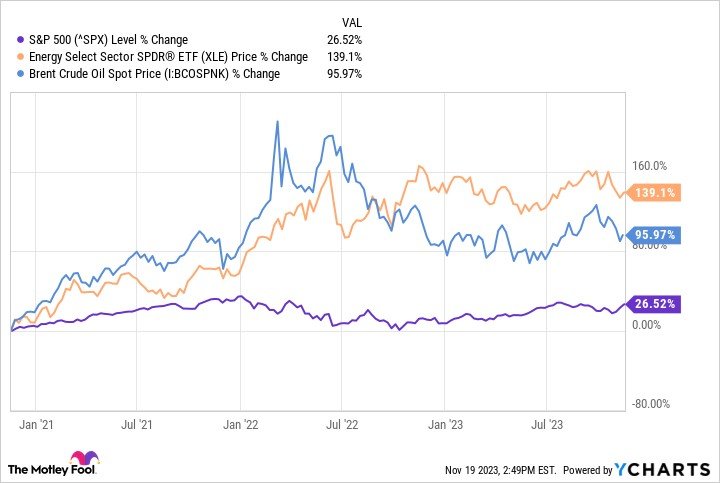
2. Vanguard Energy ETF
2. Vanguard Energy ETF
The Vanguard Energy ETF is a broad-based fund providing investors with exposure to companies involved in producing energy products such as oil, natural gas, and coal. The fund held 110 energy stocks as of late 2023.
However, because it also has a market weight strategy, it's highly concentrated at the top. Its five largest holdings include:
- ExxonMobil: 23.4% of the fund's holdings.
- Chevron: 15.1%.
- ConocoPhillips: 7.1%.
- SLB: 4.1%.
- EOG Resources: 3.7%.
The oil ETF also features a low ETF expense ratio of 0.10%. Given its broader focus on energy stocks beyond those listed in the S&P 500, the ETF provides investors with even more diversification benefits for a low cost, helping to reduce risk. It can also deliver a solid performance compared to oil prices during a strong oil market:
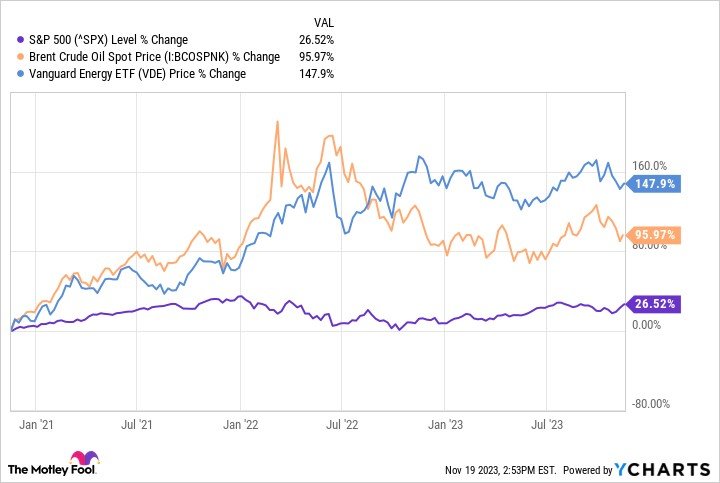
3. Alerian MLP ETF
3. Alerian MLP ETF
The Alerian MLP ETF is a fund that allows investors to target energy infrastructure midstream master limited partnerships (MLPs). These companies make money by providing midstream services such as operating pipelines or liquefied natural gas (LNG) export facilities.
They tend to earn steadier cash flow than oil and gas producers, making them better oil dividend stocks since they tend to pay high-yielding dividends. In late 2023, the ETF offered a dividend yield approaching 8%, making it ideal for investors seeking to generate passive income from the oil market.
The ETF had 13 holdings in late 2023, led by the following five:
- Plains All American Pipeline (NYSE:PAA): 13.8% of the fund's holdings.
- Enterprise Products Partners (EPD 0.18%): 13.7%.
- MPLX (MPLX 0.55%): 13.7%.
- Energy Transfer (ET 1.97%): 13.7%.
- Western Midstream Partners (WES 0.64%): 12.3%.
One drawback of the ETF is its relatively higher expense ratio of 0.85%. The fees eat into the income that the fund's holdings produce. However, the cost can be worth it because it lets investors own a basket of income-producing energy companies with a single investment.
As a yield-focused vehicle, dividend payments make up a sizable portion of the fund's total returns:
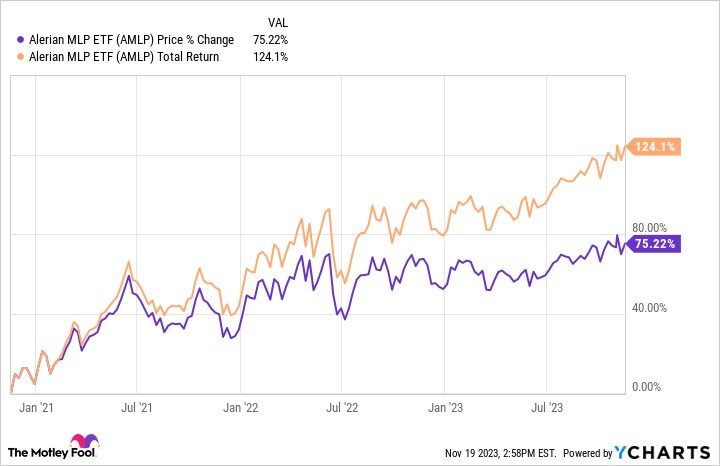
4. SPDR SP Oil and Gas Exploration and Production ETF
4. SPDR S&P Oil & Gas Exploration & Production ETF
The SPDR S&P Oil & Gas Exploration & Production ETF gives investors exposure to integrated oil and gas companies, oil and gas exploration and production companies, and refining and marketing companies. The fund had 56 holdings as of late 2023, led by:
- Range Resources (RRC 0.17%): 2.9% of the fund's holding.
- Southwestern Energy (SWN 0.14%): 2.8%.
- Chord Energy (CHRD -1.36%): 2.7%.
- Diamondback Energy (FANG -0.77%): 2.7%.
- Pioneer Natural Resources (PXD 0.07%): 2.7%.
The oil ETF takes an equal-weight approach. As such, it provides very broad and diversified exposure to the entire U.S. oil industry by owning almost equal amounts of each oil stock. Meanwhile, it charges a reasonable fee of 0.35%. These features make it a great option for investors looking for a less-concentrated oil ETF focused on oil and gas companies. It can also produce solid returns relative to oil prices:
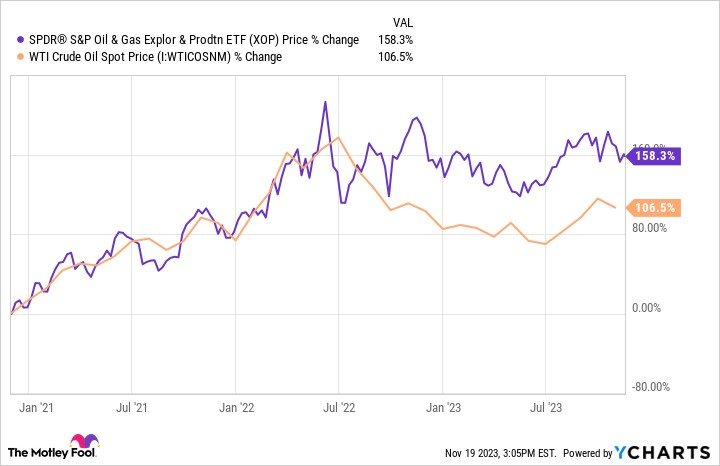
5. United States Oil Fund LP
5. United States Oil Fund LP
The United States Oil Fund is an exchange-traded security that provides investors with more direct exposure to oil prices. It invests in futures contracts based on WTI prices. This approach allows investors to make a directional bet on the price of oil without having to engage in futures trading or risk that an oil stock investment will underperform the price of crude oil.
However, the fund has a rather hefty total expense ratio of 0.6%. The costs of rolling futures contracts also can eat into the fund's return over the long term, causing it to lag the price of oil over longer periods. Because of these drags on performance, the oil ETF isn't an ideal long-term investment. Instead, it's best for making a short-term wager on crude oil prices since it tends to do a good job of tracking WTI prices over short periods:
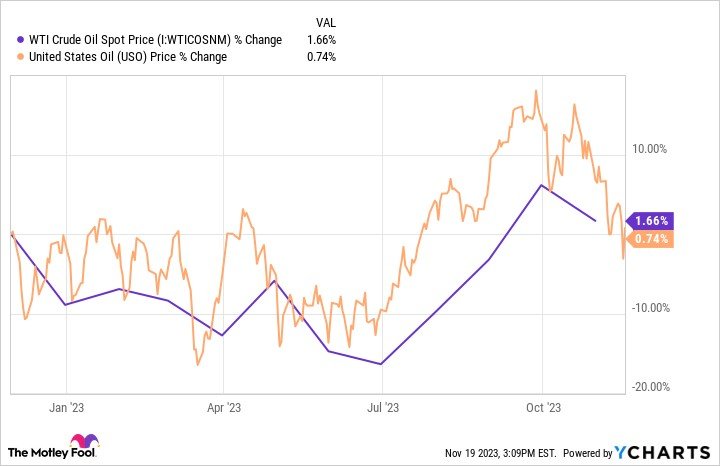
Increased exposure
Oil ETFs help investors gain increased exposure to the oil market
The oil industry is challenging for investors because of its volatility and other risk factors. However, it's also essential for the economy. Investors will want to consider having some exposure to the oil market in their portfolio.
Oil ETFs make getting into the sector easy by allowing investors to potentially profit from the sector's upside through either holding a basket of oil stocks or an ETF focused on crude oil prices. There are several top oil stock ETFs, giving investors many easy ways to add some oil market exposure to their portfolios.
FAQs on investing in oil ETFs
What is the largest oil ETF?
The Energy Select Sector SPDR Fund is the largest ETF focused on oil and gas exploration and production. The fund had almost $38 billion in assets under management in late 2023, consisting of energy stocks listed in the S&P 500 index.
What is a good oil and gas ETF?
A good ETF for those seeking balanced exposure to the U.S. oil and gas sector is the SPDR S&P Oil & Gas Exploration & Production ETF. The fund had a roughly equal weighting to almost 60 oil and gas stocks as of late 2023. That differentiated it from many of the top oil and gas ETFs, which have a market-weighting strategy. That approach results in relatively high concentration in the largest oil and gas stocks, increasing an investor's risk.












